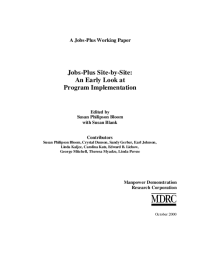Jobs-Plus: An Early Look at Program Implementation
The national Jobs-Plus demonstration represents an ambitious attempt to transform low-work, high-welfare public housing developments into high-work, low-welfare communities. Relying on three program components - employment-related activities and services, enhanced financial incentives to work, and community-based support for work - the program aims to create steady employment for a substantial majority of all working-age, nondisabled development residents. This report documents the nature and extent of program implementation in the seven cities initially included in the Jobs-Plus demonstration. It provides a "snapshot" of each site, detailing infrastructure (including staffing and facilities), program flow (including outreach, enrollment, orientation, assessment, job-related activities, and education-or-training-related initiatives), financial incentives for work, and community supports for work. It also raises three main questions for future implementation research: (1) How do sites implement and integrate financial incentives and community support for work? (2) How do residents respond to what Jobs-Plus offers? (3) What are the most feasible implementation strategies and the best practices?







